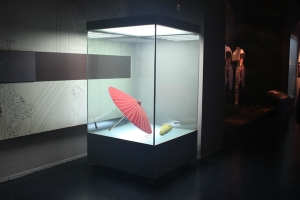新闻 · 中心
- 文物展柜里面的微生物和害虫的危害性
- 本站编辑:杭州万龙展览展示有限公司发布日期:2020-02-20 18:45 浏览次数:
文物展柜里面展示的文物发霉和霉菌污点是由空气中滋生的多种多样的微生物生成的。在通风良好的温湿度较低的环境条件下他们不可能“生长”器物即使受到影响,也能保持稳定。
木质藏品,他们异常活跃并组建造成结构上的损坏。这些昆虫能把木材内部钻孔,使外部成为一个薄薄的壳,然后把目标转到下一件藏品。他们留下的微粒,叫做蛀屑,是正在侵袭的证据。通常使用甲醛、甲基溴(溴化甲烷)或环氧乙烷蒸汽熏蒸灭杀。也可以使用绿化碳氢化合物和多种杀虫剂配方的洗涤剂局部处理。钻孔虫病害主要存在于不通风的温暖环境、高湿环境以及树脂含量低的木材中。
微生物通常在相对湿度70%、温度15摄氏度以上的热带地区、不流通或封闭环境中,以及在富含纤维素或蛋白质材料的表面生长比较旺盛。在纸张或织物上它们会产生常见的黄褐色斑,但是也可以在许多材料表面形成各种颜色和形式的生物群体。

出现轻微变色且不影响美观时,可能只需简单地降低相对湿度和温度,并将器物放置在通风良好的地方就足够了,这样可以使展品状况稳定。然而,长期储存在热带环境条件下,污染可能加重,必须在机械清除孢子及其副产物之后进行消毒和杀菌处理。
用麝香草酚蒸汽诱捕并杀死印刷品和书画上面微生物的传统方法,现在仍在使用。也可以使用其他熏剂,例如甲醛蒸汽和环氧乙烷。人类学藏品、装饰物、工业或农业制品受到霉菌和真菌的持续侵害时,也可采取熏蒸处理。
The moldy cultural relics and mildew stains displayed in the cultural relics exhibition cabinet are generated by a variety of microorganisms growing in the air. It is impossible for them to "grow" utensils in a well ventilated environment with low temperature and humidity, even if they are affected, they can remain stable.
Wooden collections, they are extremely active and build into structural damage. These insects can drill the interior of the wood, making the exterior a thin shell, and then move the target to the next collection. The particles they leave behind, called mothballs, are evidence of an attack. Formaldehyde, methyl bromide (methyl bromide) or ethylene oxide are usually used for fumigation. It can also be treated locally with detergents formulated with green hydrocarbons and a variety of insecticides. The borer diseases mainly exist in the non ventilated warm environment, high humidity environment and wood with low resin content.
Microorganisms usually grow vigorously in tropical areas with relative humidity of 70% and temperature of more than 15 ℃, in non circulating or closed environment, and on surfaces rich in cellulose or protein materials. They can produce common yellow and brown spots on paper or fabric, but they can also form biological groups of various colors and forms on the surface of many materials.
In case of slight discoloration without affecting the appearance, it may be enough to simply reduce the relative humidity and temperature, and place the objects in a well ventilated place, so as to make the exhibits stable. However, long-term storage in the tropical environment may aggravate the pollution. It is necessary to disinfect and sterilize the spores and their by-products after mechanical removal.
The traditional method of trapping and killing microorganisms on printed matter and paintings with thymol steam is still in use. Other fumigants such as formaldehyde vapor and ethylene oxide can also be used. When anthropological collections, ornaments, industrial or agricultural products are continuously damaged by molds and fungi, they can also be fumigated.
- 上一篇:你知道博物馆展柜的优劣如何区分吗?
- 下一篇:博物馆展柜的重要性
地址/ADD
杭州市西湖区三墩镇汇禾领府2-901
座机 / Tel
0571 88762810
手机 / phone